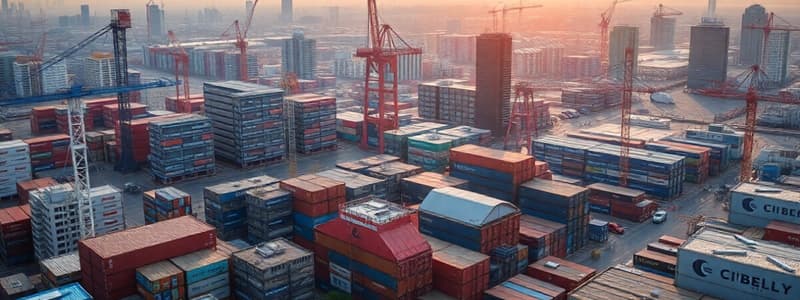Podcast
Questions and Answers
What is the primary determinant of international competitiveness?
What is the primary determinant of international competitiveness?
- Education and Skills
- Innovation and Technology
- Productivity (correct)
- Exchange Rates
A rise in the Real Exchange Rate (RER) indicates an increase in a country's competitiveness.
A rise in the Real Exchange Rate (RER) indicates an increase in a country's competitiveness.
False (B)
What is the formula for calculating Unit Labor Costs (ULC)?
What is the formula for calculating Unit Labor Costs (ULC)?
Total wages / Output
A decrease in domestic production due to increased import competition may result from __________ policy.
A decrease in domestic production due to increased import competition may result from __________ policy.
Match the following strategies to enhance competitiveness with their descriptions:
Match the following strategies to enhance competitiveness with their descriptions:
Which of the following factors is NOT part of the Global Competitiveness Index (GCI)?
Which of the following factors is NOT part of the Global Competitiveness Index (GCI)?
Wage costs and unit labor costs directly impact a country's international competitiveness.
Wage costs and unit labor costs directly impact a country's international competitiveness.
What does an appreciation of a country's currency do to its exports?
What does an appreciation of a country's currency do to its exports?
Flashcards
International Competitiveness
International Competitiveness
A country's ability to produce goods and services that meet global standards while increasing citizens' income.
Productivity (Competitiveness)
Productivity (Competitiveness)
Higher productivity reduces production costs and boosts output, crucial for competitiveness.
Exchange Rates (Competitiveness)
Exchange Rates (Competitiveness)
Affecting the cost of imports and exports in international markets, affecting competitiveness.
Unit Labor Costs (ULC)
Unit Labor Costs (ULC)
Signup and view all the flashcards
Real Exchange Rate (RER)
Real Exchange Rate (RER)
Signup and view all the flashcards
Export Promotion
Export Promotion
Signup and view all the flashcards
Import Substitution
Import Substitution
Signup and view all the flashcards
Global Competitiveness Index (GCI)
Global Competitiveness Index (GCI)
Signup and view all the flashcards
Study Notes
International Competitiveness
- International competitiveness is a nation's ability to produce goods/services that meet global standards while boosting citizen incomes. It's vital for economic growth & trade performance.
Determinants of Competitiveness
- Productivity: Crucial; higher productivity lowers production costs & increases output.
- Exchange Rates: Affect international prices. Appreciation makes exports costly & imports cheaper. Depreciation does the opposite.
- Wage Costs/Unit Labor Costs (ULC): ULC = Total Wages / Output. Lower ULCs improve competitiveness, reducing production costs.
- Innovation & Technology: Investment in R&D creates better products and efficient production.
- Infrastructure: Good transport, communication, and energy systems lower business costs.
- Education & Skills: A well-trained workforce boosts productivity and innovation.
Measuring Competitiveness
- Real Exchange Rate (RER): RER = (Nominal Exchange Rate × Domestic Price Level) / Foreign Price Level. A rising RER signifies a country becoming less competitive (exports more expensive).
- Global Competitiveness Index (GCI): Published by World Economic Forum, evaluates countries based on infrastructure, education, innovation, and macroeconomic stability.
Strategies to Enhance Competitiveness
- Export Promotion: Policies support domestic industries to compete globally (e.g., subsidies, tax incentives).
- Import Substitution: Reduces reliance on imports by boosting domestic production of previously imported goods.
- Industrial Policy: Government intervention helps key industries (e.g., technology sectors).
- Trade Liberalization: Reduces tariffs & non-tariff barriers for competition and efficiency.
Challenges to Competitiveness
- Rising labor costs without productivity gains.
- Overvalued currencies hindering export competitiveness.
- Protectionist policies in trading partners limiting market access.
- Technological gaps between developed and developing countries.
Studying That Suits You
Use AI to generate personalized quizzes and flashcards to suit your learning preferences.
Description
This quiz examines the concept of international competitiveness, focusing on factors such as productivity, exchange rates, wage costs, and innovation. Understanding these determinants is essential for grasping how nations can enhance their economic growth and trade performance. Test your knowledge on the critical elements that influence a country's ability to compete globally.




